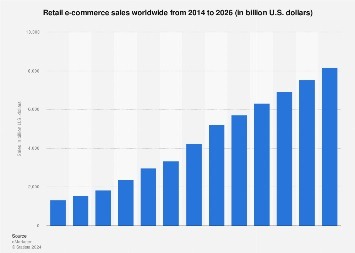
The Integration of WMS with E-commerce Platforms: Meeting the Demands of Multichannel Fulfillment
E-commerce has experienced explosive growth, with global retail e-commerce sales in the order of $5.5 trillion in 2023. This surge is fueled by evolving consumer expectations, who now demand instant gratification, convenience, and a unified shopping experience across all channels. To keep pace, retailers must optimize their fulfillment strategies by integrating their WMS with e-commerce platforms. In this article, I explore how WMS is evolving to meet these demands and ensure efficient operations.
The Omnichannel Challenge
The graph courtesy of Statista shows how E-commerce is reshaping the distribution and retailers industry, rendering it vital for retailers to focus on omnichannel fulfillment.

Omnichannel fulfillment involves delivering a consistent and cohesive shopping experience across multiple sales channels, such as brick-and-mortar stores, e-commerce websites, and mobile apps. Consumers today expect a range of options, including same-day delivery, next-day delivery, buy-online-pickup-in-store (BOPIS), and more. Meeting these demands requires retailers to have a robust and adaptable supply chain and warehouse operations.
The Integration of WMS with E-commerce Imperative:
Traditionally, WMS managed warehouse operations in isolation, while e-commerce platforms handled online sales. However, this isolated approach creates inefficiencies and hinders the omnichannel experience. Integrating these systems provides real-time data visibility, streamlines workflows, and empowers retailers to fulfill orders seamlessly across diverse channels.
Adapting WMS for Omnichannel Fulfillment
Integrating a WMS with e-commerce requires that the Warehouse Management Systems have the following features:
Real-time Inventory Visibility: One of the fundamental requirements for omnichannel success is real-time inventory visibility. WMS plays a crucial role by providing up-to-the-minute information on the status and location of products within the warehouse. Integrating WMS with e-commerce platforms ensures that customers have accurate information about product availability, which helps reduce out-of-stock situations and minimizes overstocking.
Efficient Order Processing: Efficient order processing is vital in meeting same-day delivery and click-and-collect demands. Modern WMS have advanced algorithms and automation capabilities that enable them to optimize order picking, packing, and shipping. Integration with e-commerce platforms allows for the seamless transfer of orders from the online storefront to the warehouse, reducing the risk of errors and delays.
Flexible Fulfillment Options: To meet customer expectations, retailers must offer various fulfillment options. WMS can handle diverse fulfillment methods, including ship-from-store, BOPIS, curbside pickup, and drop shipping. Integration of WMS with e-commerce platforms enables retailers to offer these options.
Dynamic Slotting: Dynamic slotting is a feature that helps maximize warehouse space and efficiency. WMS can automatically optimize the allocation of products in the warehouse based on factors like demand, product dimensions, and order frequency, ensuring that popular items are readily accessible for quick fulfillment.
Enhanced Visibility and Analytics: The integration of WMS with e-commerce platforms gives retailers enhanced visibility into their warehouse operations. Real-time data and analytics help identify bottlenecks, optimize workflows, and make data-driven decisions. Retailers can also gain insights into customer preferences and buying patterns, allowing for more accurate inventory forecasting and demand planning.
Scalability and Flexibility: Retailers experience fluctuations in demand, especially during peak shopping seasons. Modern WMS are designed to be scalable and flexible, allowing businesses to adapt to changing requirements quickly. Integration with e-commerce platforms ensures that the system can handle increased order volumes and new sales channels seamlessly.
Returns Management: Efficient returns processing is a critical aspect of omnichannel fulfillment. Integration between WMS and e-commerce platforms streamlines the returns process, reducing the time it takes to process and restock returned items, ultimately improving customer satisfaction.
Conclusion
Integrating Warehouse Management Systems with e-commerce platforms is a fundamental component for achieving success in omnichannel fulfillment, including same-day delivery and click-and-collect services. Retailers that invest in modern WMS and harness their capabilities will be well-positioned to meet customer expectations, optimize warehouse operations, and thrive in the competitive world of e-commerce. As consumer demands continue to evolve, the adaptability and efficiency of WMS will be paramount in staying ahead of the competitors.
I hope this article about E-commerce and WMS integration has been helpful to you. I will continue to post information related to warehouse management, distribution practices and trends, and the economy in general. If you are interested in learning more, click the link, and we will call you.
There is a lot of relevant information on our channel. Check this video on how to Get Consumers To Pick Your Products At Retail Stores.


Sorry, the comment form is closed at this time.